One more Barn Owl post and then I’ll give them a rest for a while.
Lately I’ve spent a lot of time watching these birds hunt and I’ve become intrigued by the process and their adaptations for doing so. Hunting over deep snow presents unique challenges because their prey (typically voles) spends most of their time in tunnels under the surface, so the owls are often hunting by sound alone. According to Birds of North America Online (out of Cornell) Barn Owls hunt prey by sound more effectively than any other animal ever tested (I’m unsure if this statement takes into account the use of sonar by cetaceans and ultrasonic sounds by bats but BNA seldom gets things like this wrong).
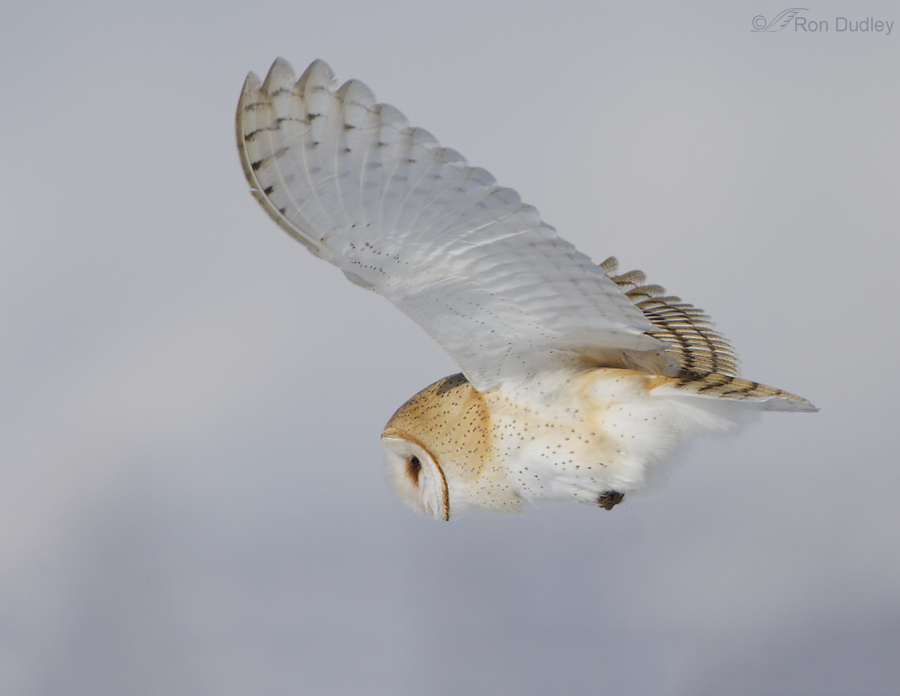
1/3200, f/7.1, ISO 500, 500 f/4, 1.4 tc, natural light, not baited, set up or called in
They fly low and slow over the surface while watching and listening but with this much snow they usually locate the voles only by sound. Notice that they can tuck their legs up into their ventral feathers so far that only the feet are visible. It’s amazing that they can do so because…
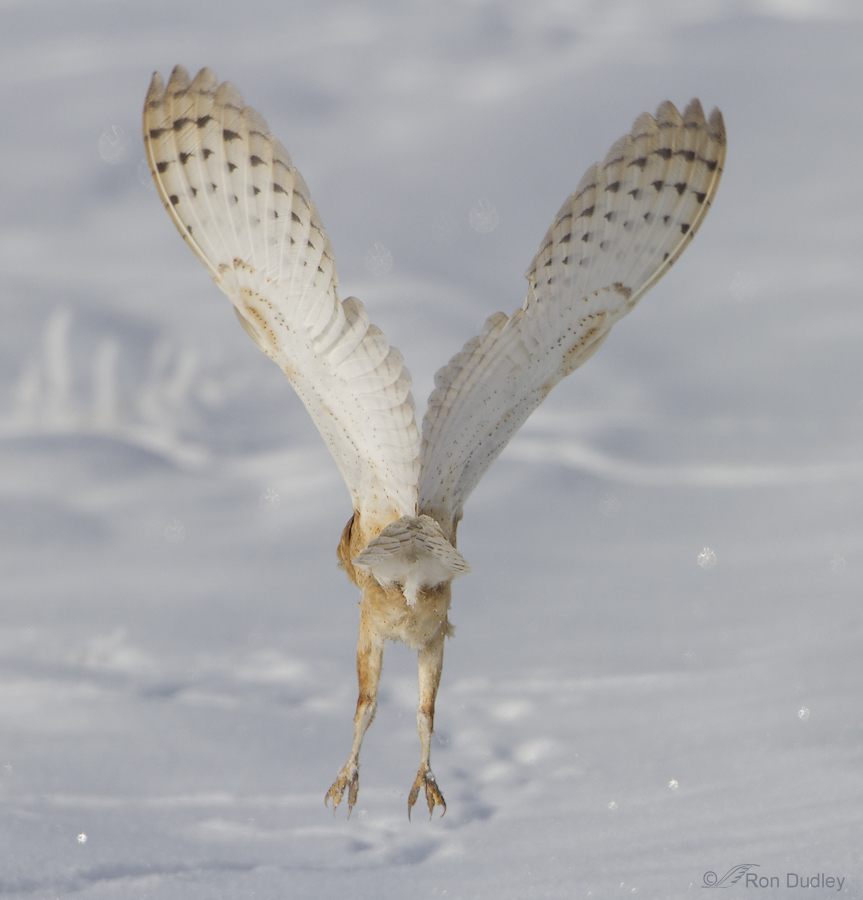
1/3200, f/7.1, ISO 500, 500 f/4, 1.4 tc, natural light, not baited, set up or called in
as you can see in this “butt shot” those legs are incredibly long. This is an adaptation for grasping prey through deep vegetation or snow. Their claws (nails) are unusually long and sharp and the middle nail has a pectinate inner edge, most likely an adaptation for grasping prey and for grooming. It’s thrilling to watch them plunge into the snow in an attempt to snag the unseen prey.
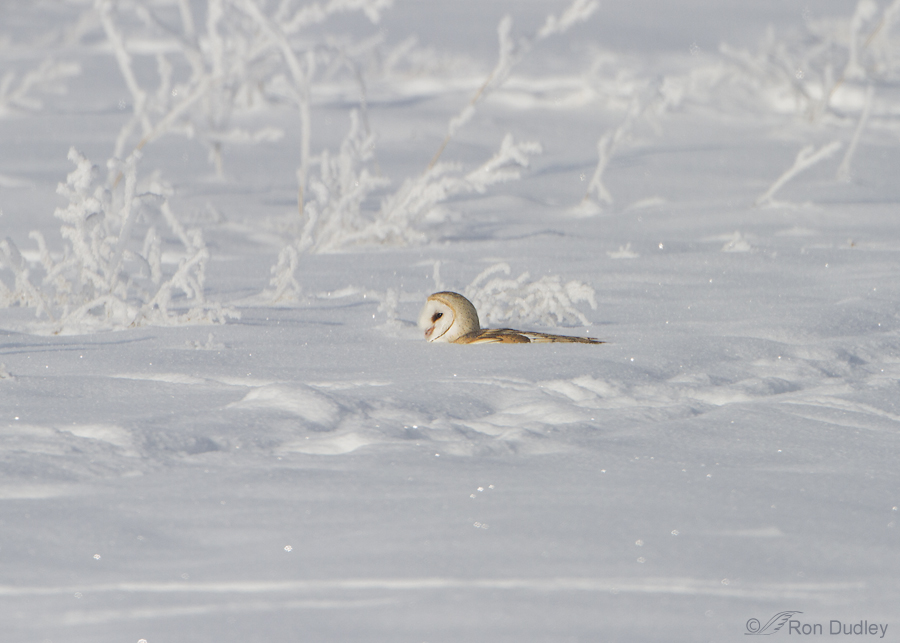
1/3200, f/7.1, ISO 500, 500 f/4, 1.4 tc, natural light, not baited, set up or called in
Sometimes they almost disappear in the deep powder. Imagine how far into the snow those long legs were able to reach in search of the vole. The owl was unsuccessful this time.
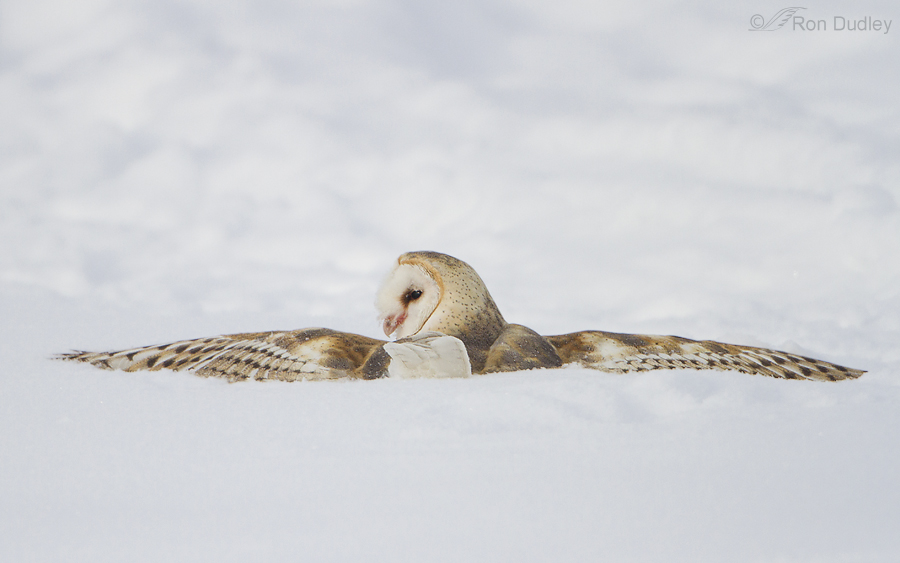
1/3200, f/5.6, ISO 500, 500 f/4, 1.4 tc, natural light, not baited, set up or called in
Yesterday morning I watched this owl plunge into the snow and was excited that it was so close but of course it was facing away from me.
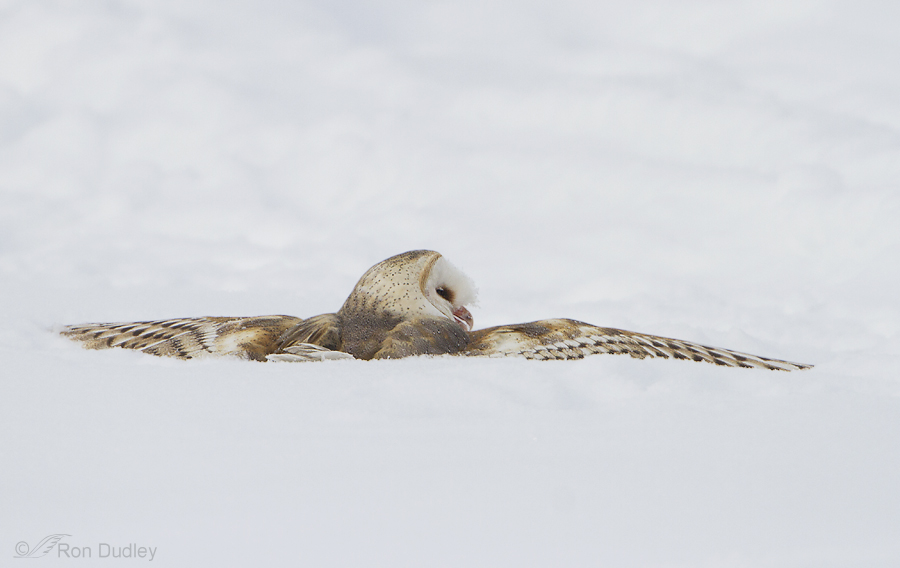
1/2000, f/7.1, ISO 640, 500 f/4, 1.4 tc, natural light, not baited, set up or called in
At first I wasn’t sure if it had caught the vole or not because even when unsuccessful these birds often sit in the snow for a short time before taking off again. One of the things I like about this shot is that we can see at least part of both the upper and lower mandibles – something not easily seen clearly in this species.
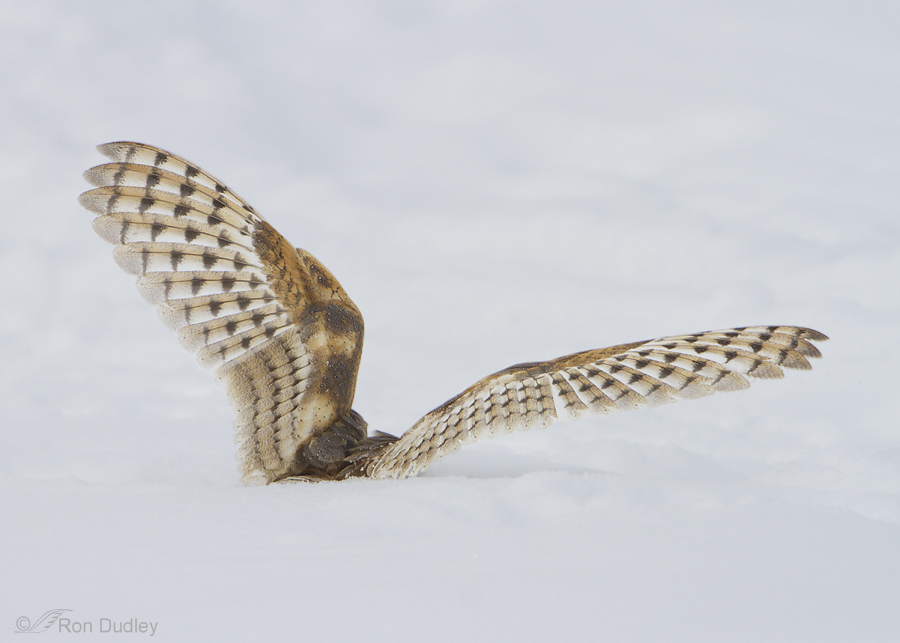
1/2000, f/7.1, ISO 640, 500 f/4, 1.4 tc, natural light, not baited, set up or called in
But this bird struggled with “something” under the snow for over 9 minutes, so even though I didn’t actually see the owl eating the vole (they often swallow them whole) I’m fairly certain that it enjoyed a meal.
It was very cold (about 7 degrees F) and when this bird took off it landed on a nearby hill and just stood there, shivering almost constantly. Life is tough for Barn Owls this winter.
Ron
Note: Here’s a link to a local newspaper article that should give you some idea of just how difficult it is for birds in northern Utah this winter.


Fantastic series of photos. Not an easy task for these rather light bodied birds. And yes, a crust of ice definitely is a rough development for them, deep snow being rough enough.
Hi Ron, The Barn Owl series form yet another outstanding chapter in your ongoing “Natural History For Everyone” posts. Truly wonderful images and information. I’m still waiting for your book…
Another Amazing series. I love your work and envy youre local fauna
I wish we got Barn Owl in Alberta but they have not documented one here in decades
Been having plenty of Snowy Owls here this year tho.
If you have a minute see my new page Ron @
https://www.facebook.com/RuttingBuckImagery
You have truly been an inspiration for me and I’d love to know what you think
Vow..Thanks so much for your very good images.These images really provide me a new knowledge that the common Barn Owl has a very good adaptation to the environment, so my conclusion is that this species is able to live almost everywhere on earth…
Thank you, Senglim. And you’re absolutely right – the Barn Owl is not only one of the most widespread of all owl species it’s one of the most widespread of all terrestrial birds.
My seven year old wants to know why there aren’t people who care “enough” to feed the owls – “get some meat, and give it to them?” We’re having a discussion about this and now the five year old has joined in, and their idea is to have a very large post and attach rats on sticks. Hmm… as you see, we have a long way to go here. They seem to understand the concept of natural selection- the good hunters eat and live, the bad ones don’t and die, therefore not passing on their genes…
Fabulous photos, as always. They are my favorites. THANK YOU!!!!!
I imagine that’s a difficult concept to explain to children that age, Nicole. But I have confidence that you’ll do it well. My best to both of your kids – sounds like they’re well on their way to becoming budding naturalists.
Nicole, as strongly as I feel about baiting owls for photos, your children’s comments about hungry owls are valid, especially from a compassion standpoint. Thank goodness they care, how very lovely. Their creative response made me chuckle … “rats on sticks” … did they mean like ratcicles? 🙂 The brilliance of that imagination. I don’t imagine they thought this equation all the way through, though.
Great pictures! I hope the temperatures get a little warmer for you and allow the snow to melt for easier hunting for the Barn Owls.
It’s finally supposed to warm up into the 30’s for the daytime highs for the next week or so, Sam. Hopefully the owls and other birds that have survived will get some relief.
Just fascinating… I had no idea they plunged so deeply into that snow. But it makes sense. And as always, your images beautifully and perfectly demonstrate the behavior.
Thank you, Christina.
As far as I’m concerned, you can keep with the barn owls, no problem. Down here in south Texas we never see them in that plumage, and have no snow.
I may be posting some more down the road, Lane – if there’s any of them left after this terrible weather.
Great quality images and information. I’ll send a bit of our warmth your way in the hope it thaws the ice and snow and encourages voles to proliferate!
Thanks Wally, we could certainly use some of your warmer temps!
I had no idea they sunk so deep in the snow. It’s impressive, and how they get back out again.
Maria, They sink that deep when the snow is soft and powdery. But last night we had freezing rain that put a hard crust on the snow. I suspect that will make successful hunting almost impossible for them…
I love your barn owl posts and hope you never “give them a rest.”
Fascinating commentary and exquisite photos (as per usual). As hard as life is for these beautiful creatures, I love your images of them in the snowy settings. Their coloring against the backdrop of snow in this soft light with your talent makes for images that are so, so fine.
BTW, that’s about the best “butt shot” I’ve ever seen & the mandible shot is wonderful as well. I had no idea how large barn owls’ mouthes really were until I saw a drawing one’s skull.
Thank you so much for these and yesterday’s as well.
Glad you enjoyed the butt shot, Sharon. I remember complaining out loud at the angle the bird gave me when it took off but I’m glad I kept the shot for this post.
Such a beautiful bird, and your pics and info are most engaging. The long leg shot is something I have never seen, thanks for your enthusiasm and generosity in providing these images.
Thanks very much, Tana. Yes, those long legs are very impressive, especially with those “knives” at the end of them…